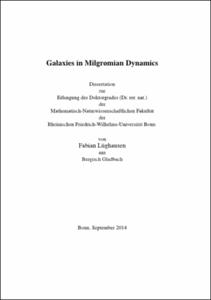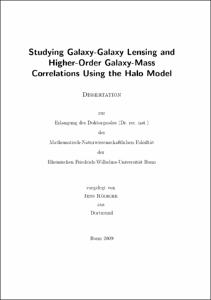Lüghausen, Fabian: Galaxies in Milgromian Dynamics. - Bonn, 2015. - Dissertation, Rheinische Friedrich-Wilhelms-Universität Bonn.
Online-Ausgabe in bonndoc: https://nbn-resolving.org/urn:nbn:de:hbz:5n-38974
Online-Ausgabe in bonndoc: https://nbn-resolving.org/urn:nbn:de:hbz:5n-38974
@phdthesis{handle:20.500.11811/6407,
urn: https://nbn-resolving.org/urn:nbn:de:hbz:5n-38974,
author = {{Fabian Lüghausen}},
title = {Galaxies in Milgromian Dynamics},
school = {Rheinische Friedrich-Wilhelms-Universität Bonn},
year = 2015,
month = feb,
note = {Since its first formulation in 1983, Milgromian dynamics (also known as modified Newtonian dynamics or MOND) has been very successful in predicting the gravitational potential of galaxies from the distribution of baryons alone, including general scaling relations and detailed rotation curves of large statistical samples of individual galaxies covering a large range of masses and sizes. To date, with only very few Milgromian N-body codes and simulations available, only little is actually known about the time-evolution of dynamical objects within that framework, and generic, fully dynamical tests using N-body codes with live particles, high spatial resolution, and full treatment of hydrodynamics are still completely missing. In the course of this thesis, I developed such a code, allowing to simulate generically the formation and evolution of galaxies in the Milgromian framework for the first time. The code is based on the hydrodynamics and N-body code RAMSES, and achieves exceptionally high spatial and temporal resolutions thanks to the adaptive mesh refinement technique. Three research projects emerged during this development:
(i) Polar ring galaxies are modelled and compared to observational data. The qualitative and quantitative analysis of those models shows that the derived Milgromian potential accounts well for their dynamical properties, whereby this is not possible in the dark matter framework unless extreme fine tuning is assumed.
(ii) The dynamical properties of the five most massive Milky Way dwarf spheroidal satellites expected in Milgrom's modified gravity framework are investigated and compared to available observational data, taking into account self-consistently the external field of the Milky Way, which strongly affects the satellites' internal dynamics.
This external field effect provides further, very stringent tests on this theoretical framework, and it turns out to resolve the "dark matter `core vs. cusp' problem" naturally in the tested objects.
(iii) The final N-body code is presented and explained. Test results are shown, and sample applications are provided (spherical equilibrium models, exponential disk galaxies, with and without initial bulge), which constitute the basis of future projects with the new Milgromian dynamics simulation code, as is evident from the significant interest this code has been receiving.},
url = {https://hdl.handle.net/20.500.11811/6407}
}
urn: https://nbn-resolving.org/urn:nbn:de:hbz:5n-38974,
author = {{Fabian Lüghausen}},
title = {Galaxies in Milgromian Dynamics},
school = {Rheinische Friedrich-Wilhelms-Universität Bonn},
year = 2015,
month = feb,
note = {Since its first formulation in 1983, Milgromian dynamics (also known as modified Newtonian dynamics or MOND) has been very successful in predicting the gravitational potential of galaxies from the distribution of baryons alone, including general scaling relations and detailed rotation curves of large statistical samples of individual galaxies covering a large range of masses and sizes. To date, with only very few Milgromian N-body codes and simulations available, only little is actually known about the time-evolution of dynamical objects within that framework, and generic, fully dynamical tests using N-body codes with live particles, high spatial resolution, and full treatment of hydrodynamics are still completely missing. In the course of this thesis, I developed such a code, allowing to simulate generically the formation and evolution of galaxies in the Milgromian framework for the first time. The code is based on the hydrodynamics and N-body code RAMSES, and achieves exceptionally high spatial and temporal resolutions thanks to the adaptive mesh refinement technique. Three research projects emerged during this development:
(i) Polar ring galaxies are modelled and compared to observational data. The qualitative and quantitative analysis of those models shows that the derived Milgromian potential accounts well for their dynamical properties, whereby this is not possible in the dark matter framework unless extreme fine tuning is assumed.
(ii) The dynamical properties of the five most massive Milky Way dwarf spheroidal satellites expected in Milgrom's modified gravity framework are investigated and compared to available observational data, taking into account self-consistently the external field of the Milky Way, which strongly affects the satellites' internal dynamics.
This external field effect provides further, very stringent tests on this theoretical framework, and it turns out to resolve the "dark matter `core vs. cusp' problem" naturally in the tested objects.
(iii) The final N-body code is presented and explained. Test results are shown, and sample applications are provided (spherical equilibrium models, exponential disk galaxies, with and without initial bulge), which constitute the basis of future projects with the new Milgromian dynamics simulation code, as is evident from the significant interest this code has been receiving.},
url = {https://hdl.handle.net/20.500.11811/6407}
}









